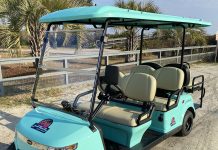PLEASE NOTE: Golf Cart Laws may vary from City to City, so please be sure to check with your local municipality in regards to the laws in your area. We are in the process of gathering laws by municipality for you, however, this is a huge undertaking and does take time. Thank you.
This is an in-depth guide to Illinois Golf Cart & Low-Speed Vehicle Laws. We’ve created this guide to help you, the consumer, in determining Illinois’s laws.
Is this state Medium Speed Vehicle friendly? No State Law is Currently in Place.
Is License and Registration a Requirement? For LSVs, yes (Cost for Title is $30, plus registration is $18). For Golf Carts, registration is not required, but a valid driver’s license is. The display of a slow-moving vehicle emblem is also required on the rear of the cart.
General Federal Law for Golf Carts:
Under current NHTSA interpretations and regulations, so long as golf cars and other similar vehicles are incapable of exceeding 20 miles per hour, they are subject to only state and local requirements regarding safety equipment. However, if these vehicles are originally manufactured so that they can go faster than 20 miles per hour, they are treated as motor vehicles under Federal law.
The standard requires low-speed vehicles to be equipped with headlamps, stop lamps, turn signal lamps, taillamps, reflex reflectors, parking brakes, rearview mirrors, windshields, seat belts, and vehicle identification numbers.
Find out more information on federal laws pertaining to golf carts and low speed vehicles here.
Illinois Golf Cart & Low Speed Vehicle Laws
Guidelines for Golf Carts and PTVs (Personal Transportation Vehicles)
Illinois State Law allows for local jurisdictions to permit the operation of golf carts on city streets “if the unit of local government determines that the public safety will not be jeopardized.“
A VALID DRIVER’S LICENSE IS REQUIRED IN ORDER TO OPERATE A GOLF CART ON PUBLIC ROADS.
STATE MINIMUM LIABILITY INSURANCE IS ALSO REQUIRED.
Golf Carts are only allowed to operate on roadways with a posted speed limit of 35 MPH or less. Golf Carts may, however, CROSS streets or roads with a posted speed limit above 35 MPH. This DOES NOT include State and Federal Highways. Golf Carts may never drive on or cross a tollroad, interstate highway, or controlled access highway.
No non-highway vehicle may be operated on a roadway unless, at a minimum, it has the following:
Brakes, a steering apparatus, tires, a rearview mirror, red reflectorized warning devices in the front and rear, a slow moving emblem on the rear of the non-highway vehicle, a headlight that emits a white light visible from a distance of 500 feet to the front, a tail lamp that emits a red light visible from at least 100 feet from the rear, brake lights, and turn signals
Golf Carts operated on public roadways must have the following:
- Brakes
- A Steering Apparatus
- Tires
- Rearview Mirror
- Red reflectorized warning devices in the front and rear
- A slow moving emblem on the rear
- A headlight that emits a white light visible from a distance of 500 feet to the front
- A tail lamp that emits a red light visible from at least 100 feet from the rear
- Brake lights
- Turn signals
Important Side Note:
If a roadway is under the jurisdiction of more than one unit of government, golf carts may not be operated on the roadway unless each unit of government agrees and takes action as provided in this subsection.
Guidelines for LSV (Low Speed Vehicle)
- Has four wheels.
- Can reach a speed of more than 20 miles per hour (mph) but not more than 25 mph on a paved level surface.
- Has a 17-digit conforming vehicle identification number (VIN)
- Has a gross vehicle weight rating (GVWR) of less than 3,000 pounds.
- Must be certified to meet Federal Motor Vehicle Safety Standards (FMVSS) to be registered and operated on public streets, roads, or highways.
- Not be operated on any roadway with a speed limit above 30 mph. Local ordinance, however, may allow use on roads with a posted speed limit of 35 mph or less
- May not cross a street with a speed limit in excess of 45 miles per hour unless the crossing is at an intersection controlled by a traffic light or 4-way stop sign.
LSVs may look like a golf cart to the casual observer, but is actually a motor vehicle requiring a valid driver license, registration, and insurance.
HELPFUL LINKS
www.ilga.gov – Golf Carts
www.ilga.gov – Low-Speed Vehicles
Disclaimer
Although each of these state guides gives a thorough approach to the golf cart laws in your state, it is recommended that you perform the research on your own and reach out to your local municipality.
Recent News & Helpful Articles












